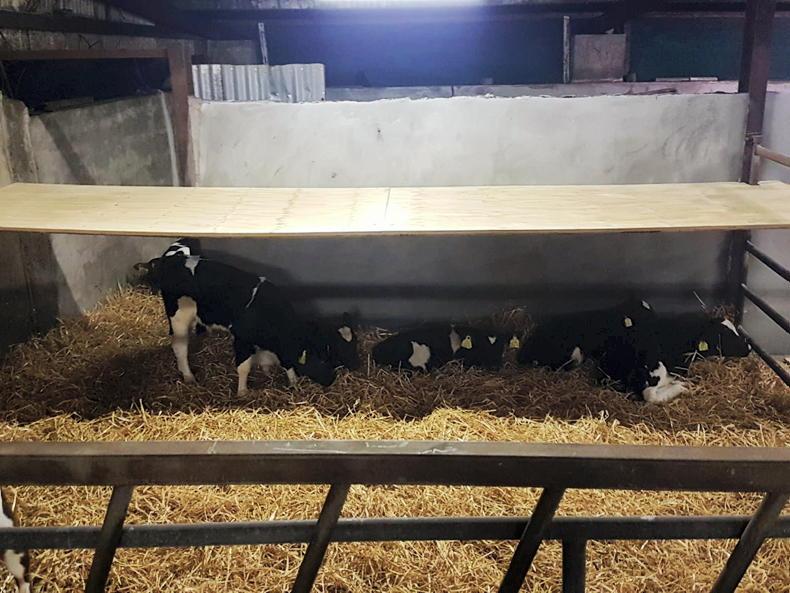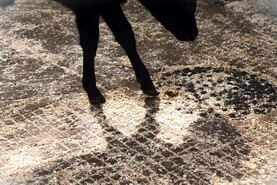The weather over the coming days looks set to stay quite cold with daytime temperatures struggling to get much above freezing. Ideally the ambient temperature in the calf rearing shed would be 15°C. While this is highly unlikely – even for normal early-spring temperatures – there a number of things farmers can do to minimise the impact of sub-optimal temperatures.
Bedding in the rearing shed should never be skimped on, but in cold weather farmers really need to focus on providing a deep, dry straw bed for calves. Young calves will actually nest in straw which helps to keep them insulated.
A good rule of thumb is that when you put your palm firmly onto the bedding, the straw around your hand is up to your elbow. Bedding also needs to be dry as wet bedding will reduce the calf’s core temperature. Kneel down on the bedding for a minute. When you stand up, if your knees are wet, the bedding is insufficient.
Calf-rearing sheds need to have good air ventilation but also need to be draught free at calf level. Physically get down to calf level and see if there are draughts in your calf accommodation. Common problem areas are along feed barriers and under gates.
Creating micro-climates at the back of calf pens allows calves somewhere sheltered to lie during cold periods of weather. These can be simply constructed in almost all calf housing.

A calf micro-climate at the back of the pen provides a sheltered area for calves to lie.
While they shouldn’t be needed for every calf, calf jackets can be a good addition for young or weak calves during periods of extreme cold.
Again, the science behind a calf jacket is it is trying to maintain that warmer environment for the calf so that it can concentrate most of its energy intake to growth rather than just maintaining its body temperature. Jackets should be breathable and washable and where fitted should be regularly checked and adjusted to ensure they fit correctly on the growing calf.
4. Feed extra milk replacer
I have left this option to last as it needs careful consideration before doing. When the cold spell is expected to be quite short as this one is, I would be reluctant to change feeding rates as it can cause digestive upsets. An extra 2% milk replacer can be offered for every degree drop below 10°C. Any alterations to feeding rates should be done gradually over a few days. Likewise, once temperatures return to normal, the transition back to normal feeding levels should be stepped back over a period of feeds.

The weather over the coming days looks set to stay quite cold with daytime temperatures struggling to get much above freezing. Ideally the ambient temperature in the calf rearing shed would be 15°C. While this is highly unlikely – even for normal early-spring temperatures – there a number of things farmers can do to minimise the impact of sub-optimal temperatures.
Bedding in the rearing shed should never be skimped on, but in cold weather farmers really need to focus on providing a deep, dry straw bed for calves. Young calves will actually nest in straw which helps to keep them insulated.
A good rule of thumb is that when you put your palm firmly onto the bedding, the straw around your hand is up to your elbow. Bedding also needs to be dry as wet bedding will reduce the calf’s core temperature. Kneel down on the bedding for a minute. When you stand up, if your knees are wet, the bedding is insufficient.
Calf-rearing sheds need to have good air ventilation but also need to be draught free at calf level. Physically get down to calf level and see if there are draughts in your calf accommodation. Common problem areas are along feed barriers and under gates.
Creating micro-climates at the back of calf pens allows calves somewhere sheltered to lie during cold periods of weather. These can be simply constructed in almost all calf housing.

A calf micro-climate at the back of the pen provides a sheltered area for calves to lie.
While they shouldn’t be needed for every calf, calf jackets can be a good addition for young or weak calves during periods of extreme cold.
Again, the science behind a calf jacket is it is trying to maintain that warmer environment for the calf so that it can concentrate most of its energy intake to growth rather than just maintaining its body temperature. Jackets should be breathable and washable and where fitted should be regularly checked and adjusted to ensure they fit correctly on the growing calf.
4. Feed extra milk replacer
I have left this option to last as it needs careful consideration before doing. When the cold spell is expected to be quite short as this one is, I would be reluctant to change feeding rates as it can cause digestive upsets. An extra 2% milk replacer can be offered for every degree drop below 10°C. Any alterations to feeding rates should be done gradually over a few days. Likewise, once temperatures return to normal, the transition back to normal feeding levels should be stepped back over a period of feeds.









 This is a subscriber-only article
This is a subscriber-only article










SHARING OPTIONS: